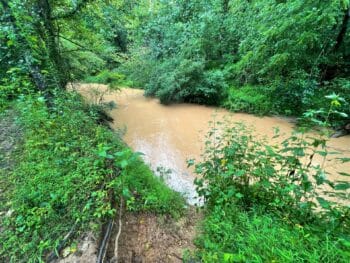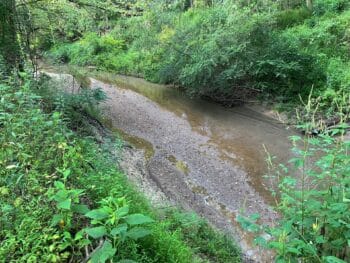NEWS
Davidson Conservationists Helped Spare Trees, Natural Areas in Path of Stream Project – and Save Mecklenburg County $1 Million

When Mecklenburg County scheduled the $5 million “restoration” of the West Branch of the Rocky River, east of Davidson, some local people recoiled in horror.
The West Branch, county stormwater experts say, is in dire need of help. The stream flows half-hidden under steep, eroding banks that the county says wash sediment into the water, and downstream, with each hard rain. Large trees sometimes fall into the creek as the banks collapse. Fixing that would be one of the county’s largest stream restorations.
 But the 1.7 mile-stretch the county targeted – an initial phase upstream was finished in May – also borders land treasured by walkers, birders and conservationists. That’s the 200 acres of fields and woods at Davidson’s Fisher Farm Park and the county-owned, 345-acre Abersham Park just upstream.
But the 1.7 mile-stretch the county targeted – an initial phase upstream was finished in May – also borders land treasured by walkers, birders and conservationists. That’s the 200 acres of fields and woods at Davidson’s Fisher Farm Park and the county-owned, 345-acre Abersham Park just upstream.
The two sides agreed on one thing: stream restoration, no matter the end result, starts with the ugly work of cutting down trees and digging up tons of dirt. Banks are often “totally denuded,” the county says, before being shaved into gentler slopes and replanted with native species.
“We could see the destruction coming,” said Cathy Denham, a science teacher and Davidson Lands Conservancy member.
The recent restoration of a tributary stream at Fisher Farm, paid for by the state transportation department, had left a galling eyesore – a small mountain of leftover soil. The West Branch project, Denham said, would also have caused needless damage such as burying a field of milkweed, the plants that feed monarch butterfly larvae, in excavated dirt.
The Davidson Lands Conservancy serves as monitor of a conservation easement that the county holds at Fisher Farm and has urged the county to similarly protect Abersham. Once the conservancy became aware of the West Branch plan, the group asked county and Davidson officials to allow time for the public to comment on it.
The unusual seven-month community review that followed – county water experts and engineers debating Davidson College scientists and local conservationists – found more to agree on.
Davidson town commissioners heard their joint recommendations on Aug. 23 and are expected to vote on a stormwater easement allowing the work on Sept. 13. Commissioner Ryan Fay credited county officials with their willingness to work with local critics of the project.
The result after months of work: The county agreed to scale back excavation, the most expensive part of the West Branch project, by 30 percent. Large trees will be spared, and bigger ones replanted. Spoil dirt will be placed on nearby private property and in less environmentally damaging places. The changes cut project costs, paid for by county stormwater fees, by $1 million.
less environmentally damaging places. The changes cut project costs, paid for by county stormwater fees, by $1 million.
The review also broke new ground for the county’s 24-year-old stream restoration program.
“We haven’t had a group that wanted to get into so many of the design details of a project before,” said Tim Trautman, who leads the engineering and mitigation program for Charlotte-Mecklenburg Storm Water Services. “Usually when we’ve met with folks, it was about one specific issue. In Davidson, they were wanting to know the ‘why’ behind the science. That’s very unusual for citizen groups.”
The Davidson contingent questioned the county’s estimates of how quickly wildlife habitat and streambed creatures will recover in and along the reengineered stream. They dug into the climate impacts of carbon that will be released when trees are cut and soils exposed.
And they argued that restoring a portion of the West Branch wouldn’t shield it from the force of water surging downstream from the direction of fast-developing Mooresville, where 90 percent of its drainage area lies.
Davidson College geologist Brad Johnson, who has studied local stream restorations for more than a decade, proposed simply leaving the creek alone. After years of human impacts – the West Branch was probably dredged and straightened decades ago to protect farmland — Johnson says it’s time to “let the stream find its own equilibrium.”
“If we’re just changing to a new ‘unnatural’ stream, I don’t see the point of that,” he said, “especially since there isn’t a lot of evidence that stream restorations improve the environment in this region.”
The county disagrees, but Johnson and others involved say the community review reached a fair compromise.
Trautman’s staff believes the changes the county agreed to will result in fewer long-term environmental benefits for the West Branch. But he said those “fairly minor tradeoffs” will still help keep sediment out of the creek, put excavated soil in better places and save money for other uses.
“Focusing disturbance on places that are already disturbed … the focus on saving trees – broadly, I’m pretty happy with it,” Johnson said. “At the end of the day, if they canceled the project I’d be happier.”
Will the creek’s creatures return?
How do creeks in such bucolic settings reach such a poor state? Look to the steady spread of streets, buildings and parking lots all around us. And to the sky.
Rain falling on hard surfaces can’t soak into the ground. Instead it surges toward the nearest waterway, sweeping oil, metals and chemicals with it. A one-inch rain falling on Mecklenburg County sends two billion gallons of stormwater into its streams.
The volume and force of the gushing water gnaws at stream banks. Sediment blankets habitat for fish and aquatic insects in the stream bed. Nutrients such as lawn fertilizers, attached to sediment particles, raise the odds of algal blooms and fish kills.
Stream restoration aims to reverse those trends.
Mecklenburg County ranks upcoming projects, and measures their results, by a system that is “based on the overall greatest net benefit to restoring the biological community.” But restoration initially destroys or displaces fish, aquatic insects and terrestrial wildlife, the county acknowledges.
“It takes time for the stream and surrounding riparian areas to recover, but the ultimate result is improved water quality and aquatic habitat through the creation of stable channel conditions,” a county report says. “Parklands are also better protected from channel erosion and habitat from varied species of flora and fauna is enhanced.”
Past restorations, the county says, showed sediment from eroding banks typically drops by 90 percent within a year of completion. Plants grow tall enough to shade the streams, a benefit because cooler water holds more oxygen, in five to 10 years. Aquatic organisms reach “full recovery” within a decade, the county says.
Chris Paradise, a biology professor at Davidson College, isn’t so sure about that.
Some of his students study the aquatic insects in local streambeds. A recent restoration at Huntersville’s Torrence Creek, which Paradise has sampled periodically for more than a decade, tried to replicate natural habitat with rocks and gravel of different sizes. But he said silt from development in the watershed filled in the spaces between the rock and left no places for insects to live.
“I think we’re afraid that will happen at West Branch,” Paradise said.
Aquatic insects such as caddisflies, stoneflies and mayflies perform many functions in streams. They’re food for fish and birds, but some are also predators. Others decompose organic material that falls into streams and, helpfully to humans, serve as indicators of healthy water quality.
Once they’re dug out of the West Branch, Paradise said, it’s anyone’s guess whether they can return. Human activity in the watershed, Paradise said, works against it.
It’s also unclear, Johnson added, what would have been lost if the county had followed its initial plan of dumping excavated dirt on open fields. That would have buried generations of plant, insect and microbe communities in the soil, he said, while inviting invasive species into the newly-disturbed ground.
“Old fields have ancestry, like old-growth forest,” Johnson said. “Things will come back if we agree not to disturb them.”
Their differences remain, but Davidson College scientists, the lands conservancy and the county will collaborate on long-term maintenance and monitoring of the restoration once it’s finished.
“Our data and findings of (post-restoration) improvements and those of Chris and Brad are different,” Trautman said. “So we are both excited to partner on a 10-year monitoring plan and will share data with each other.”
Denham’s push for the county to more deeply assess the carbon releases of the West Branch project could influence future restoration projects. She plans to push elected officials to make climate impacts a priority in future water-quality projects, such as by protecting buffers around degraded streams instead of rebuilding them.
Stormwater officials have never calculated the net gain or loss of carbon from their projects, Trautman said, but are discussing with county air quality staff whether they should start doing that.
Large signs at Fisher Farm and Abersham, meanwhile, describe the upcoming West Branch project, which is expected to start early next year if county commissioners approve and will take 12 to 18 months.
“We were able to get some improvement,” said Davidson Lands Conservancy member Hayden Boyd, who took part in the community review. “But the immediate impact will be quite dramatic, because they will still be taking out a lot of trees and excavating a lot of dirt.”
+++++++++++++++++++++++++++++++++++++++++++++++
Bruce Henderson recently retired from the Charlotte Observer, where he wrote about the environment for two decades. He’s a Morganton native and proud UNC Chapel Hill grad. Bruce and his wife Lynn have lived in Davidson since 1985.


